Potential environmental impacts of HVDC
The following discussion largely summarizes a paper by L. A. Koshcheev (2003) on the potential environmental impacts of HVDC overhead transmission lines in comparison to HVAC lines. In the paper, Koshcheev points out that an HVDC transmission system provides environmental benefits over conventional AC technology. The land coverage and the associated ROW are less for a DC transmission line.
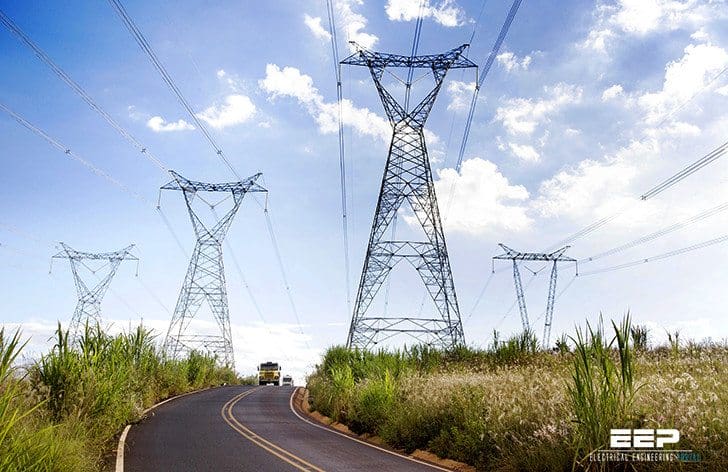
DC transmission lines require two conductors versus three for comparable AC lines.
This feature reduces the visual impact and allows greater power to flow over the same ROW, thus maximizing resources. In addition, the EMF effects associated with HVAC transmission lines are not present in HVDC lines.
The possible influences on the environment caused by high-power electricity transmission systems, either AC or DC, include:
- The effects of electric fields
- The effects of magnetic fields
- Radio interference
- Audible noise
- Ground currents and corrosion effects
HVDC lines have some characteristics that canbe considered as “positives,” while other HVDC characteristics may be “negatives” from anenvironmental point of view, relative to corresponding characteristics of HVAC lines.
Characteristics of HVDC lines have to be taken into account during the process of choosing transmission line routings and while planning a transmission line project.
In the following paragraphs, each of the environmental impacts noted above is discussed with reference to the technical features of HVDC transmission systems.
1. Effects of Electric Fields
The electric field produced by a HVDC transmission line is a combination of the electrostatic field created by the line voltage and the space charge field due to the charge produced by the line’s corona. Investigations of the environmental influence of electric fields around HVDC transmission lines performed in Canada and Russia have shown that the discomfort to humans that is typically felt under HVAC transmission lines is not observed under HVDC lines.
This discomfort arises from spark discharges from humans to bushes, grass, and other vegetation.
Subjectively, the sensation perceived by a human standing under a HVDC overhead line does not usually go beyond the electrostatic stimulation of hair movement on the head. Such results suggest that electrostatic fields below HVDC transmission lines are limited and generally are not hazardous to humans.
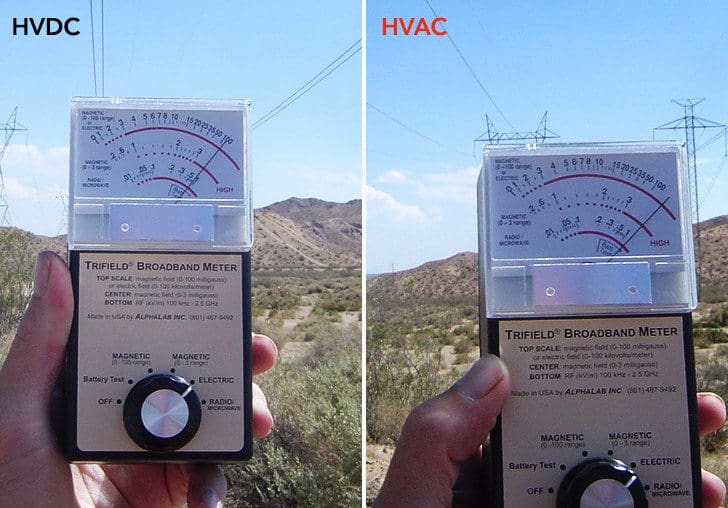

A study done in Canada found that large machines with rubber tires (such as combine harvesters, automobiles, and someothers) are not electrically charged to dangerous levels when the machines are standing under HVDC overhead lines.
The electrical resistance in the tires of these machines, while high (at about 10 megaohms), turns out to be low enough to prevent the accumulation of a dangerous charge (via charge leakage) even when the machine is standing on dry asphalt. In the case of HVAC overhead lines, induced capacitive currents on large machines may reach dangerous levels.
Measurements show that in good weather the ion current existing under an HVDC overhead line (corona) can lead to an increase in the concentration of positive ions in the air from normal 103 – 104 levels to 106 – 107 per cubic inch. During precipitation events, however, this value can rise several times higher. Positive ion concentrations higher than 105 per cubic inchare considered detrimental to health due to prolonged exposure of the human respiratory tract.
The level of corona-induced space charge from HVDC lines is variable, as it depends on weather conditions. Thus, the total electric field and ion current flux near a transmission line must be described statistically. Guidelines designed to limit the health impact of electrical fields from transmission lines typically include separate limits on the total electric field of a DC line including space charge, the electrostatic field, and the ion current density.
Local codes and regulations limiting the electrical field impact exert a large influence on the design of overhead line construction, and on the resulting technical and economic performance of the HVDC transmission lines ultimately built.
Go back to HVDC environmental impacts ↑
2. Effects of Magnetic Fields
The environmental impacts of transmission line magnetic fields on humans have been less studied than the impacts of electrical fields. According to various estimates, the maximum magnetic field strength of an AC power transmission system varies from 10 to 50 μT (micro Tesla) near the line, while exposure levels at residences, for example, are typically less than 1 μT (BPA 1996).
The magnetic fields associated with DC lines produce no perceivable effects. The strength of the magnetic field around HVDC transmission lines is in the same range as that of the Earth’s natural magnetic field.
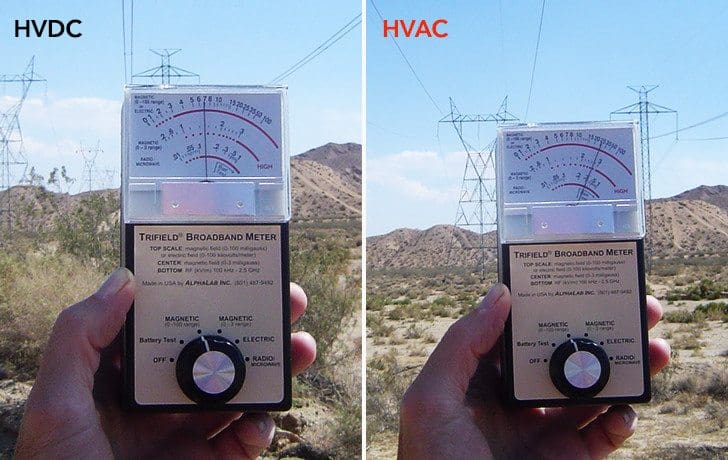

Unlike AC magnetic fields, which continuously vary in strength and polarity with the associated electric current, DC magnetic fields are of relatively constant strength, orientation, and polarity.
Since existing limits to magnetic field exposure are typically much higher than the exposure that would be encountered under HVDC transmission lines, there are effectively no guidelines relating to the design of DC lines relating to magnetic fields.
Go back to HVDC environmental impacts ↑
3. Radio Interference
The radio interference caused by electric power transmission lines is the result of the corona discharge around conductors at positive voltages. As a result, HVDC line radio interference is generated only by positively charged conductors, whereas HVAC interference is generated by all three AC phases.
AC lines contribute up to a 10 dB (decibel) increase in radio interference under rainy conditions, while DC line radio interference decreases during rain. DC radio interference levels can be limited to acceptable levels by restricting electric field gradients to about 64 kV/inch.
Radio interference levels from HVDC lines are typically 6-8 dB lower than those of HVAC lines of similar capacity.
Go back to HVDC environmental impacts ↑
4. Audible Noise
Audible noise from DC transmission lines is a broadband noise with contributions extending to high frequencies. The noise is mostprevalent in fair weather. Noise levels from a DC line will usually decrease during foul weather, unlike the noise levels on AC lines.
Audible noise from transmission lines in residential areas is typically restricted to 50 dB during the day or 40 dB at night.
HVDC transmission line operation noise usually is addressed using the same types of measures used for HVAC lines. The main source of audible noise in the HVDC converter stations, the converter transformer, can be surrounded by screens when the noise level is not acceptable.
Go back to HVDC environmental impacts ↑
5. Ground Currents and Corrosion Effects
Ground currents are associated with monopole operations of HVDC transmission lines. Monopole HVDC systems are used mostly for submarine power transmission systems, except when continuing power transfer is needed in the event of an emergency outage of one pole of an HVDC bipolar system.
In the case of an overhead bipolar line operating after an emergency outage on one pole, it may or may not be necessary to provide the opportunity for the current to pass though the Earth for the duration of the emergency.
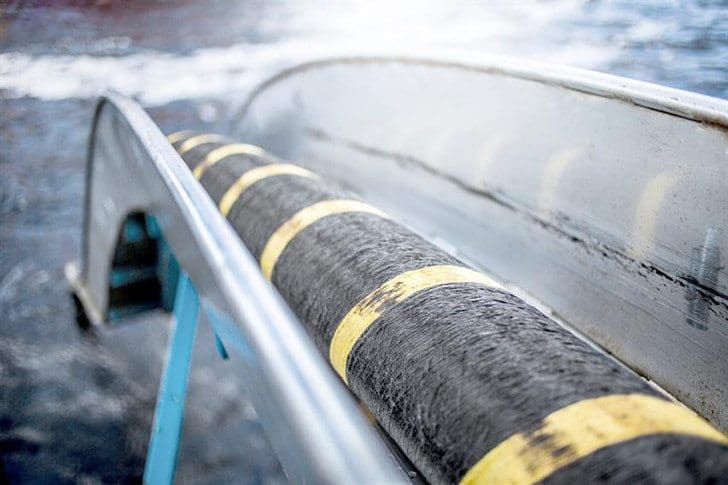

On some occasions, a conductor that normally serves as the lightning guard for the line has been used to enable monopole operation of a HVDC overhead transmission line. In the case of designs with two bipolar HVDC lines situated on one set of towers or routed through the same corridor, the overload capacity of the HVDC conductors can be used.
Typically, an HVDC overhead transmission line conductor has the effective cross section to carry double its nominal capacity without being in danger of overheating.
When “metallic return,” that is, a separate conductor not used to carry power, is used, HVDC power transmission does not produce ground currents or any attendant concerns. When the current return is through the ground, however, the current path between grounding installations of HVDC converter substations lies through the whole thickness of the Earth, while
environmental impacts are limited to the moderate area near grounding installations.
Overhead HVDC transmission lines are usually bipolar and operate in a monopole mode only in emergencies. However, all DC lines, except those with an additional conductor, produce some ground currents due to unavoidable dissymmetry when operating under a bipolar scheme.
Due to differences in current flow between the two poles, a prolonged current passes through the ground. Usually the dissymmetry current is estimated as 1-3% of the nominal current value.
Complex grounding systems for the HVDC substation are required, particularly when a “metallic return” is not available. In the latter case, grounding electrodes are situated at some distance from the substation to preclude corrosion of underground substation components. The grounding installation must be further designed to preclude dangerous step voltages from appearing near grounding electrodes.
Cathodic protection of buried pipelines orother underground metal objects near the grounding installation might be needed to prevent rapid corrosion of this infrastructure.
Go back to HVDC environmental impacts ↑
Reference // The design, construction and operation of long-distance high voltage electricity transmission technologies – J. C. Molburg, J. A. Kavicky and K. C. Picel (Argonne National Laboratory)





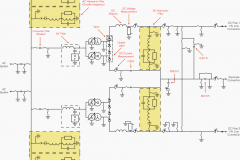
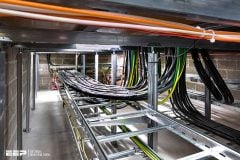




I don´t understand your EM measurements, is the same frequency range for AC and DC?? What are the voltage and current conditions in each line? And the weather conditions for electric field under the DC line, affects strongly the ion currents. Also a single measurement don´t say nothing, you need a statistical point of view.
What are the bases for the various comparisons? It is very important to compare “apples to apples”. Regards, GG
Thank U but need detailed comparative statement based on biological effects leads to harmful on living things